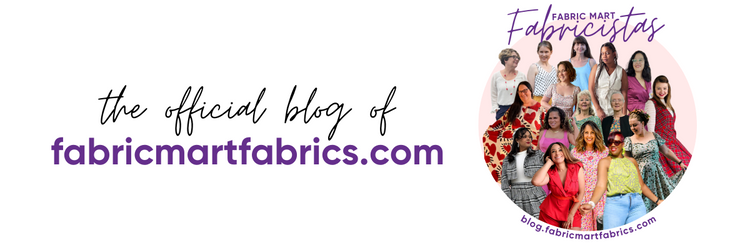To go along with the recent post, In the Studio with Dana Marie Designs, I selected one of her patterns to try out! I selected A Right to Bare Arms, a sleeveless yoke styled design that can be cut to three different lengths (tunic, knee and calf.) It has princess seams for a flattering fit and a slightly flared hem. I've seen this pattern made up many times and I'm not only going to share with you the two items I made from this pattern, but many other variations of this pattern using different fabrics! I love when a pattern can be used with a wide variety of fabrics because you're going to get something a little different every time!
The first design I made about a year ago. I used a rayon jersey knit from Fabric Mart (sorry, not available anymore) for the bodice and a ponte knit for the collar. The pattern calls for stretch knits as well as cotton, rayon or any other woven fabric with nice drape.
It is important to note that the pattern comes with two different ways to make the collar. The collar can be made from a bias-cut or a non-bias cut. I tried the bias-cut version for this tunic. BIG mistake! The finished collar does not sit nicely on my body. It curves away from me. I asked Dana for advice on what I should do with the collar. She recommended using the non-bias cut collar for knits. I don't know what I was thinking, but I'm going to take the collar off fix it! (One of these days!)
I do like however that the pattern's princess seams accentuate the body. I also like that on this tank it does not bare too much above the bust at the arms. I cut out size large in the tunic. It was good for my hips, the bodice fits nice but I felt like I should have graded down to a smaller size.
After waiting a year to make the pattern again, I decided to make it again in a top. This time I used the non-bias cut for the collar. It turned out a lot better. I used a loose-weave linen. I chose this only because I did not have any solid knits, or fabric for that matter that matched the print. Because of the loose weave in this linen, I could have used the bias-cut version, but opted not to just because of my experience with the tunic. I ended up stabilizing the collar because the weave was SO loose. The non-bias cut pattern calls for the collar to be interfaced, but I used a little heavier interfacing than normal just because my fabric was so loose!
The pattern does not actually come in a "top" length, so I cut off about 6" or so from the bottom of the pattern.The directions to the pattern are easy to follow. Just pay attention when choosing which collar to make. I would recommend using the bias-cut for wovens only! Use the non-bias collar for knits and don't forget to stablize with a knit interfacing that will stretch with the knit! And if you're worried that your woven won't fall into a bias-cut very well, use the non-bias collar. Dana also includes other design ideas in the pattern booklet. You can see many of these design ideas in the photos below.
Drape, heaviness and pattern can all make a garment look different when using the same pattern by different fabric. Here are examples of A Right to Bare Arms in different fabrics.
This is the tunic length made from a heavyweight batik linen.
This is a top length with a rayon challis batick. Collar was made from two fabrics and embellishment.
This is the tunic length made from a rayon challis from Fabric Mart! Dana also included a band just below the bust line, creating the look of an empire waist.
This is a dress length, which you would have to draft the length since the pattern comes in tunic and top length. Ponte knit was used in this design.
This is a detail of the collar. Dana cut the collar using the pattern piece method, rather than the bias method. The edges of the ponte knit were left raw and cut with scalloping shears.
This is a dress length that was featured in the Shipwreck Challenge using muslin as the main fabric. How creative! It does not look like muslin from the photo! Looks like a gorgeous silk!
Are you ready to try A Right to Bare Arms?! Click HERE to purchase it now!
I will be posting a quick tutorial on the bias-cut collar over the weekend. This post has a lot of info, so I thought it would be better to spread it out a little bit!
As you can see, the possibilities are endless! How are you going to use A Right to Bare Arms in your wardrobe?












Such a nice pattern, love to see all the incarnations in the different fabrics and lenghts. Very versatile.
ReplyDelete